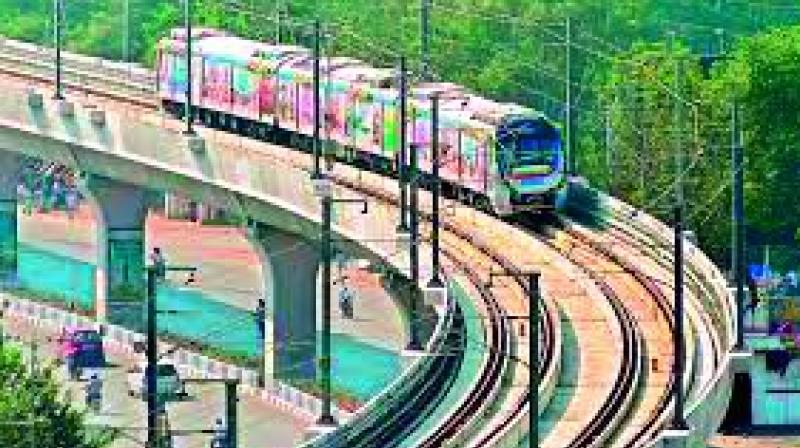Delhi Metro tops in ridership

Hyderabad: The Hyderabad Metro Rail saw a patronage of 1.1 lakh commuters on Raksha Bandhan. After the initial euphoria and besides New Year’s Eve, in August, metro patronage touched 1 lakh thrice in a fortnight.
With the inauguration of the Ameerpet to LB-Nagar metro, the ridership is expected to touch 1.5-2 lakh per day. The current ridership of Hyderabad Metro when compared to other cities is substantially low. As of August, the Delhi Metro recorded a ridership of 28 lakh per day, while Kolkata maintained 5.5 lakh and Bengaluru, recently, touched a new high of 4.28 lakh.
Hyderabad, however, is a young metro service when compared to its counterparts. An official said that the level of acceptance of the nine month old Hyderabad metro is way better than the initial acceptance for any other city.
HMR MD N.V.S Reddy said, “One lakh passengers are a good sign for the future of public transportation in Hyderabad. Bengaluru took seven years to get to the 4 lakh patronage mark. But when compared to other metros, Hyderabad metro is moving up very fast. Delhi’s initial ridership was not high but when they touched 200 km, they started getting 20 lakh commuters. Chennai even after three years is at 40,000. There are many metro stations in Hyderabad, which got more patronage than we anticipated. But the potential is much more, especially, when you connect all the corridors.”
Miyapur, KPHB, JNTU, Uppal and Nagole apart from the interchange station Ameerpet have seen significant patronage. Experts said that the patronage was high in the places where the RTC bus connectivity was not strong.
Transport researcher G S R Chaitanya said, “The western part of the city is not served well by buses. People are heavily dependent on shared autos and cabs. Evidently, more people prefer the metro train. However, the patronage will increase as currently popular areas are not being served.”
Once all the corridors are connected the ridership is going to increase. HMRL is anticipating 15 lakh ridership per day in the next two years when all three corridors are functional.
Experts pointed out that connectivity to bus stations and railway stations would increase the patronage. M Adishankar of Roadkraft said, “Currently, the connectivity to bus stations like MGBS, JBS is limited. Even at Secunderabad, there is no direct connectivity. Once the metro becomes operational in these areas, traffic will flow from all sides. Connecting to all modes of transport will be vital as the metro is here to stay.”
However, the traffic in this corridor and RTC buses continues to be chaotic with people spilling out of the doors. The task of changing transport is a put off because of which they prefer direct connectivity. “Switching modes of transport even after taking the metro is not something that people embrace. Moreover, there are socio-economic factors like bus passes and the ticket cost that need to be considered for all the sections to embrace it. For some people, time and the convenience factor is important while for others the cost should be economical,” Adishankar said.
He added the current patronage was continuing because the time spent on travel was the same in any hour of the day, while it varied on the road. However, the trend of more people utilizing it on holidays and special occasions is worth thinking about as the regular commuters may not use the metro on a holiday.
Meanwhile, Reddy said, “In the next one year, there will be massive changes, especially living conditions in Hyderabad will transform drastically. The city will get reoriented to the metro. We are immediately expecting about 5 lakh ridership, once all thecorridors are operational and in 1-1.5years around 15 lakh ridership.”

